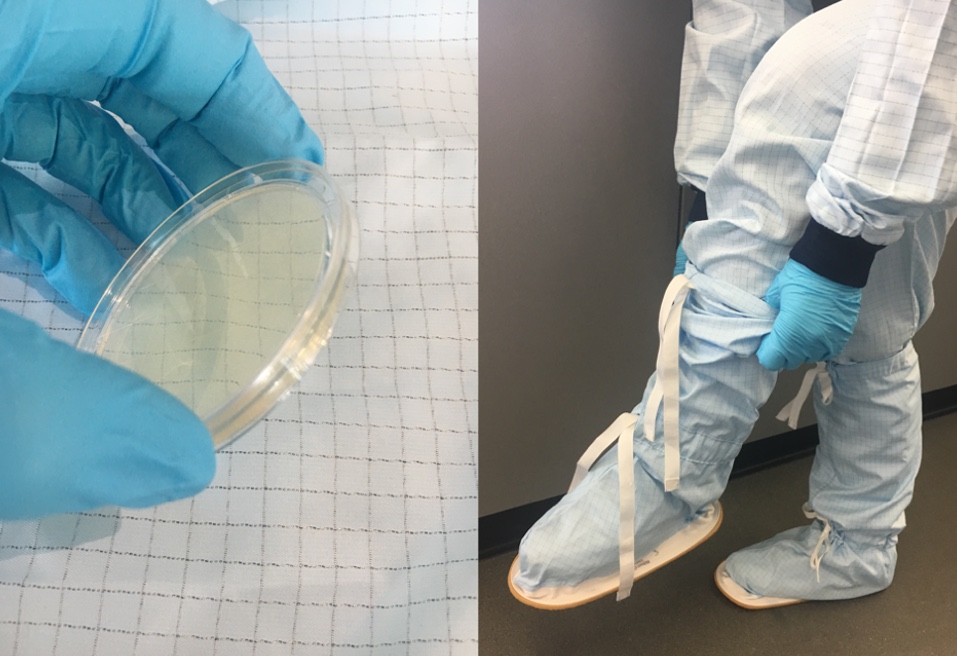Findings from recently published research reports the identification of bacterial isolates recovered from the surface of cleanroom operatives’ clothing following wear within the cleanroom environment.
Dr Laurie Smith, Lecturer in Pharmaceutical Sciences at Robert Gordon University, Aberdeen explains.
The research forms part of a much larger study, where over a 5-year period the bioburden of cleanroom operators’ garments over the user cycle including following laundering, donning and wear, was investigated. This was initially undertaken to address recurring low-level contamination events within our facility, thought to be attributed to the operators within the room. The findings from this study highlight the need for greater insight into the risk presented by operators’ and particularly their garments within in the cleanroom environment."
Operators are well established as the primary source of cleanroom contamination. Whilst cleanroom garments are reported as an effective barrier between operators and the environment, little information exists on bacterial contamination levels and the species that become depositied on the surface of such garments.
Whilst reusable garments offer a sustainable choice over disposable alternative, there is a clear need to evaluate the magnitude of cross-contamination risk
Early in our research, it became clear that reusable garments become quickly contaminated and host varying levels of bacteria following donning and use. Our findings show that the barrier garments themselves ultimately present a cross-contamination risk, with potentially negative impact on product integrity.
Microbial monitoring of operators’ clothing and identification of recovered bacteria is crucial in understanding the probable source and routes for bacterial transfer onto the garments. Such knowledge should allow for consideration of intervention strategies to help to mitigate against contamination events, and hopefully reduce the risk presented by operators overall.
With this in mind, we aimed to identify bacteria recovered from the surface of operators’ garments following wear, with a specific objective to do so also with respect to gender.
To achieve this, bacteria were recovered from the surface of both male and female operators’ garments using a direct agar plate contact method, which allowed for a quick and inexpensive way to quantify and compare bacterial levels at 7 specific garment sites.
In terms of identification, initially we relied on phenotypic methods, but found this time consuming and subjective, leading us to question the validity of the results. Subsequently, we resorted to much more robust 16S rRNA gene sequencing.
Unfortunately, the budget limited a complete quantitively study, and identification of all isolates recovered could not be undertaken. To achieve a semi-quantitative approach, 47 isolates were selected based on colonial morphology which proportionally represented the isolates recovered. Sequencing successfully identified 44 isolates to the genus level, with 36 of these further identified to the species level. Of note, these results confirmed earlier misidentification using phenotypic methods at the genus level.
Species of Staphylococcus, Micrococcus and Bacillus were most commonly identified, along with fewer Microbacterium and single isolates of Dermacoccus, Kocuria and Paenibacillus. Staphylococcus and Bacillus species were observed at similar proportions irrespective of gender, with a more diverse population on the surface of females’ garments, with increased numbers of Micrococcus, and singles isolates observed. However, greater variety could be due to the greater number of female operators tested, a limitation of our study due to the predominantly female workforce.
Whilst considering those bacteria originating from operators, the most abundant species was Micrococcus luteus, alongside several species of Staphylococcus including S.succinus and S.cohnii. Environmentally, whilst single species were observed, Bacillus species accounted for the majority from this source, including B. anthrasis, B. safensis and B. pulmis. Whilst most of the bacteria identified will cause little harm to patients receiving sterile products, others are opportunist pathogens with potential to cause infection and disease in individuals with lowered immunity. Of further concern some Bacillus species can produce spores, surviving for extended periods of time and often able to evade decontamination procedures.

Our conclusions were that during wear cleanroom clothing becomes quickly contaminated with both operator-associated and environmental bacteria. Most isolates were identified as Gram-positive bacteria, which was originally anticipated due to their abundance on the human skin and the wider environment.
Our data revealed that two-thirds of the bacterial isolates were found to originate from human skin. Whilst the majority of these organisms are thought to originate from the wearer and permeate the garments, it remains possible that a small proportion will arise from other operators working close by. The remaining bacteria were identified as originating from the natural environment, particularly soil, and were thought to be transferred into the cleanroom via the changing area and onto garments by direct contact with contaminated surfaces or by airborne particulate transmission within the room.
There appeared to be no correlation between species observed and garment site tested, however this would require more investigation to be certain. Whilst we have confirmed that reusable garments are contaminated with bacteria during wear, there is still a lack of knowledge and published literature evaluating the risk presented by these garments. Whilst reusable garments offer a sustainable choice over disposable alternative, there is a clear need to evaluate the magnitude of cross-contamination risk they present within the cleanroom environment. “To address this, we have secured funding for a follow on project that will be undertaken by a PhD student. This will examine both environmental cross-contamination risk of reusable cleanroom garments to be assessed and consider garment sustainability. We hope that such knowledge will add a small amount to the wider understanding amongst cleanroom industries and professionals and aim to increase confidence in reusable garment practice”.
The full research paper can be found in the European Journal of Parenteral and Pharmaceutical Sciences. The authors include Dr Laurie Smith, Dr Christina Lowes, Dr Noëlle O’Driscoll, and Prof Andrew Lamb.
